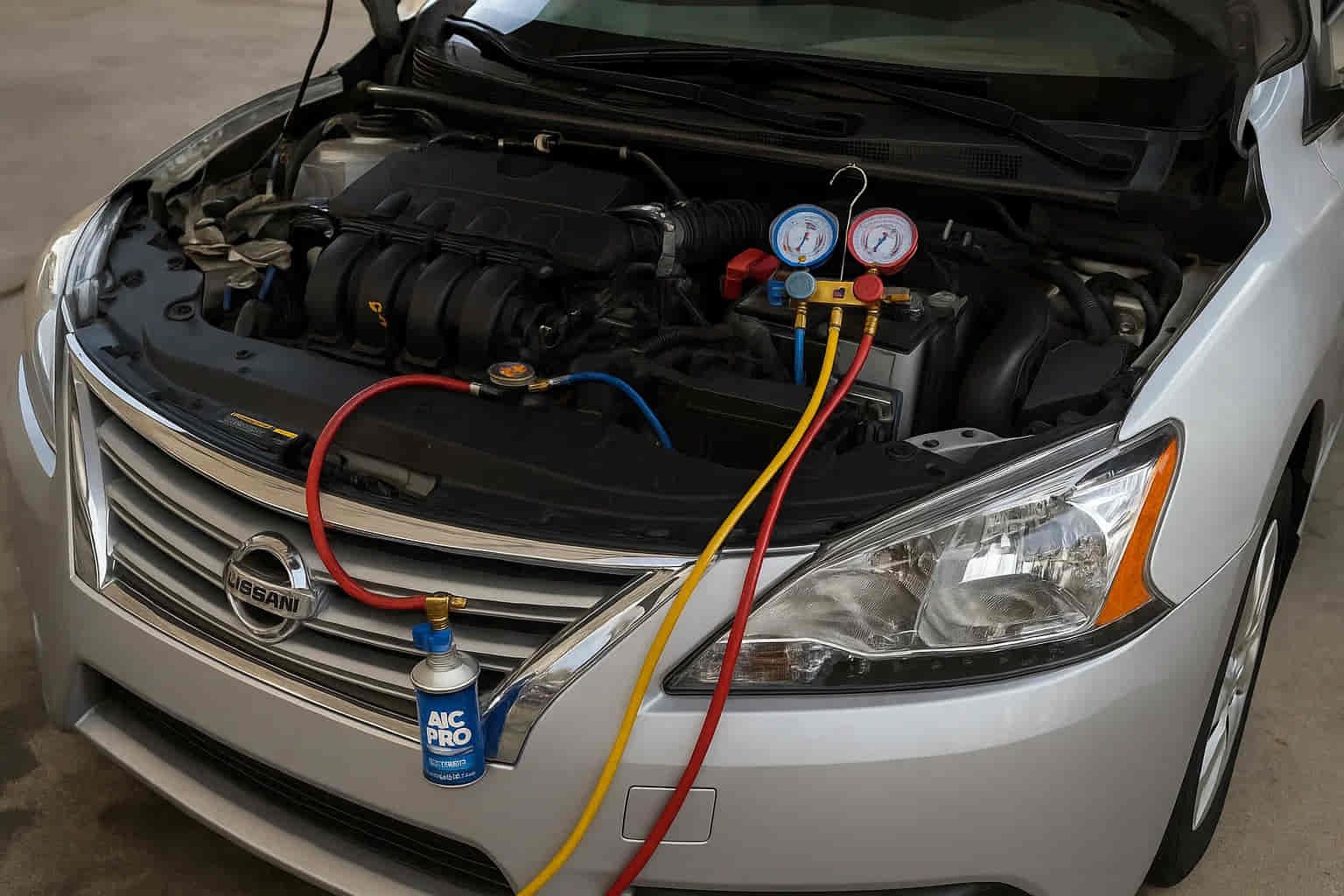Driving a Nissan Sentra in the middle of summer should be a comfortable experience, but when the air conditioning stops delivering cold air, it quickly turns into frustration. Many owners face the same problem: the cabin feels warm, the airflow is weak, and the AC system struggles to keep up. In most cases, the solution comes down to a proper Nissan Sentra AC recharge, a maintenance step that restores the refrigerant level and helps the system cool efficiently again.
Understanding how and when to recharge the AC is more than a matter of comfort; it can also prevent costly repairs. A low refrigerant level puts extra pressure on the compressor and other components, often leading to damage that requires expensive replacement. By learning the signs of a weak AC, knowing the cost differences between DIY kits and professional service, and following a safe recharge process, you can extend the life of your system and enjoy a cooler ride.
This guide will walk you through everything you need to know about a Nissan Sentra AC recharge, including costs, step-by-step instructions, and the most common problems to watch for after recharging.
Signs Your Nissan Sentra Needs an AC Recharge
One of the most frustrating moments for Nissan Sentra drivers is realizing that the air conditioning no longer cools the cabin the way it used to. The first and most obvious warning sign is warm air blowing from the vents even when the AC is set to maximum cooling. This usually indicates that the refrigerant level has dropped too low for the system to absorb and release heat effectively. Another common symptom is weak airflow, where the AC still works but feels insufficient on hot days. Drivers may also notice the compressor cycling on and off irregularly, a sign that it is struggling to maintain the correct pressure because of low refrigerant. In some cases, the AC system can produce an unpleasant smell, caused by moisture buildup when the system is not operating at full efficiency.
Ignoring these signs can lead to bigger issues than just discomfort. A compressor forced to run under low refrigerant conditions risks overheating and eventually failing, which turns a simple recharge into a costly repair. Paying attention to these early warnings and scheduling a Nissan Sentra AC recharge before the system is completely empty not only restores comfort but also protects the longevity of the AC components.
Nissan Sentra AC Recharge Cost: DIY vs Professional Service

When it comes to restoring cool air in your Sentra, cost is one of the biggest factors drivers consider. A Nissan Sentra AC recharge can be handled in two different ways: with a do-it-yourself kit or through a professional service. Choosing between the two depends on your budget, level of experience, and how much peace of mind you want.
For many owners, a DIY recharge kit is the most affordable option. Available at auto parts stores and online, these kits typically cost between $40 and $80. They come with a can of refrigerant, a pressure gauge, and a hose for easy connection. If you follow instructions carefully, you can often restore cold air in less than an hour. The main advantage is cost savings, but the downside is the risk of overcharging or overlooking an underlying leak that a kit cannot fix.
On the other hand, professional AC service usually ranges from $150 to $300, depending on location and shop rates. While it is more expensive, technicians use advanced tools to evacuate the old refrigerant, test for leaks, and refill the system to the exact factory specification. This ensures not only better cooling performance but also long-term protection for the compressor and other components. For those who value reliability or suspect a deeper issue, investing in professional service is often the smarter choice.
Step-by-Step Nissan Sentra AC Recharge Guide
Recharging the AC in a Nissan Sentra may seem intimidating at first, but with the right tools and a careful approach, it is a process most drivers can handle. The first step is preparation: gather a reliable AC recharge kit, safety glasses, and protective gloves. These items are essential because refrigerant operates under high pressure and can cause injury if mishandled.
Once you are ready, locate the low-pressure service port under the hood. On most Nissan Sentra models, this port is found on the larger aluminum line running from the compressor to the firewall. After confirming the engine is off, connect the recharge kit’s hose to the port and read the pressure gauge. If the reading shows low refrigerant, it is time to begin recharging.
Start the engine, set the air conditioning to maximum cold, and shake the refrigerant can before connecting. As you slowly add refrigerant, keep an eye on both the pressure gauge and the temperature inside the cabin. The goal is to bring the pressure into the recommended range without overcharging, as too much refrigerant can damage the compressor. It usually takes a few minutes for the system to stabilize, so patience is important.
During the process, make sure to hold the refrigerant can upright to avoid introducing liquid refrigerant directly into the system. Once the desired pressure is reached and you feel cold air blowing steadily from the vents, disconnect the hose and securely close the service port. As a final check, drive the car for a few minutes with the AC running to confirm consistent cooling. By following these steps carefully, a Nissan Sentra AC recharge can restore comfort to your ride while preventing costly mistakes.
Common Problems After an AC Recharge
Even after completing a Nissan Sentra AC recharge, some owners notice that their air conditioning still does not perform as expected. One of the most common problems is discovering that the system blows warm air again after only a few days. This usually points to a refrigerant leak, which cannot be fixed by simply adding more refrigerant. Without sealing the leak or replacing the faulty component, the problem will continue to return.
Another frequent issue is overcharging. Adding too much refrigerant increases system pressure, forcing the compressor to work harder than it should. This not only reduces cooling efficiency but can also lead to premature compressor failure, one of the most expensive AC repairs a driver can face. Some drivers also report unusual noises or vibrations coming from the AC after a recharge, often caused by uneven refrigerant distribution or damage to internal components.
Using the wrong type of refrigerant is another mistake that can create long-term damage. Most modern Sentra models require R134a or R1234yf refrigerant, and mixing them or using an incorrect substitute can shorten the lifespan of the entire system. If you suspect that the recharge did not fully solve the cooling issue, the safest approach is to have a professional mechanic perform a leak test and system inspection. Addressing these problems quickly prevents small issues from turning into costly repairs while ensuring your AC delivers consistent cooling performance.
How Often Should You Recharge the AC in a Nissan Sentra?
Unlike oil changes or tire rotations, there is no strict maintenance schedule for when a Nissan Sentra AC recharge should be performed. In many cases, the system can run for several years without needing additional refrigerant, as long as there are no leaks. On average, most Sentra owners find that a recharge becomes necessary every two to three years, especially in regions with long, hot summers where the AC is used heavily.
Climate and driving habits play an important role. If you frequently drive in stop-and-go city traffic or live in a hot, humid area, the AC system works harder and may require servicing sooner. Conversely, drivers in milder climates may go much longer before noticing a drop in cooling performance. Another factor is the condition of the system itself; older vehicles or those with worn seals may lose refrigerant faster than newer models.
The best approach is to monitor performance rather than rely on a fixed timeline. If the air no longer feels as cold as it once did, or if the compressor cycles frequently, it may be time to schedule a recharge. Incorporating AC checks into your regular maintenance routine ensures that your Sentra stays comfortable year-round and prevents costly damage caused by running the system with low refrigerant levels.
Conclusion
A properly functioning air conditioning system is more than just a comfort feature in your Nissan Sentra; it is a necessity for safe and enjoyable driving during the hottest months. When the system begins to lose its cooling power, a Nissan Sentra AC recharge often provides the solution by restoring refrigerant levels and allowing the AC to work efficiently again. Ignoring weak airflow or warm air not only makes driving uncomfortable but also risks damaging the compressor and other components, leading to costly repairs.
Whether you choose a DIY kit to save money or prefer the assurance of professional service, understanding the signs, costs, and common issues gives you the knowledge to make the right decision. A careful recharge process can bring back strong, cold airflow, while timely maintenance ensures long-term reliability of the system.
Ultimately, the key is to pay attention to your Sentra’s AC performance and act quickly when cooling begins to fade. With proper care, you can avoid unexpected breakdowns, extend the life of your AC system, and enjoy every drive in comfort. Don’t wait until summer heat becomes unbearable—make sure your Nissan Sentra’s AC is ready before you need it most.

